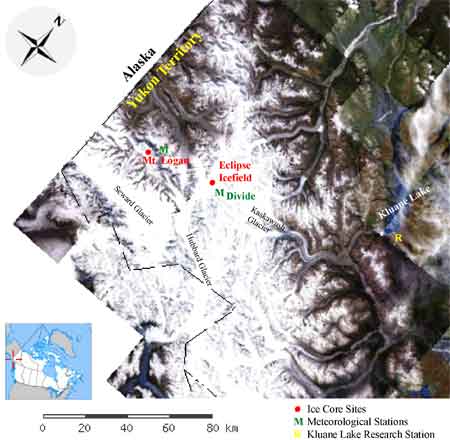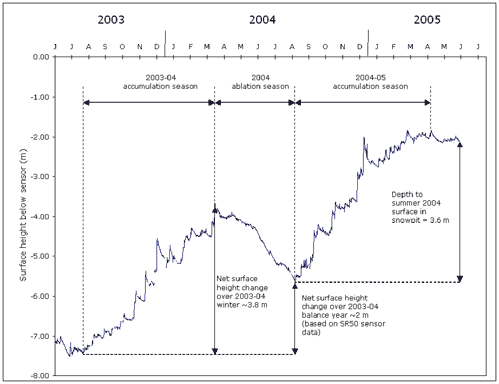in the St. Elias Mountains and the
Implications for Ice Core Research in Regions of High Relief
Nathan Vogan
Research Problem and Objectives
Recent publications in popular media sources (e.g. Time magazine) have highlighted global warming and its potential impacts on both natural (biological, ecological) and social (economical, political) systems. Understanding the climate system and trying to predict the future requires a comprehensive understanding of changes in the past, providing a basis to investigate and evaluate the linkages between the physical climate system and the many potential forcing factors. This in turn will allow for the further definition and testing of climatic boundary conditions in order to improve global circulation models, and hence hopefully better understand our future climate.

Figure 1
The Arctic represents one of the key regions on Earth to document and understand global climate change. Due to the nature of the global heat exchange from the tropics to the poles the Arctic is especially sensitive to climate perturbations. The Arctic is experiencing changes in atmospheric and oceanic circulation related to both natural climate variability and anthropogenic greenhouse gas/sulfate aerosol forcing that extends from the top of the ionosphere (~100 miles above the Earths surface) to 1000m depth in the oceans. Such changes have been manifested in, for example, decreased sea ice cover, a rise in the North Atlantic Oscillation atmospheric circulation index, reduced North Atlantic Deep Water, melting permafrost, and warming over the subpolar land areas of Alaska and Northwest Canada in winter and spring.
The Arctic plays a prominent role in global climate change research because of both its sensitivity to changing climate and because of the relative wealth of paleoenvironmental proxy records available. Proxy records developed through physical and chemical analyses of ice cores provide the highest resolution and most direct view of Earth's paleoatmosphere over time scales ranging from single seasons to hundreds of thousands of years. Recent research efforts have focused on developing high resolution ice core records from the St. Elias Mountains in southwestern Yukon Territory and southeastern Alaska (Fig 1). During the summers of 2001 and 2002, scientists from the Geological Survey of Canada (GSC), National Institute for Polar Research in Tokyo, University of New Hampshire (UNH), and University of Maine (UMaine) recovered ice cores from three different glaciers in the St. Elias Mountains, southwestern Yukon Territory. On the Eclipse Icefield (~30 km northeast of the Logan Massif) an UNH/UMaine team recovered a 345 m core along with three other shallower cores.

Figure 2. Annotated time series of snow surface height changes at the Mount Queen Mary
AWS site, as measured by the SR50 snow depth sounder.
Previous work on an ice core recovered in 1980 from Mt. Logan (Holdsworth et al, 1991, Holdsworth and Krause, 2002) has shown that major discontinuities in the variation of the water stable isotope ratios with altitude, which are believed to be derived from a multilayered atmosphere during precipitation events on high altitude glacier sites. To properly interpret the glaciochemical records developed from the new St. Elias ice cores, calibration of snow properties with meteorological data (temperature, precipitation, and sea level pressure) is critical. At the Divide Site (Fig. 1; 2800 masl), two automatic weather stations (AWS) have been operating since 2002, collecting snow depth (Fig. 2) as well as standard meteorological data. Therefore, the timing of known precisely, providing a unique opportunity to investigate the atmospheric controls on snow deposition and chemistry in the St. Elias Mountains.
The first project objective is to dig and sample a 6 m snowpit underneath the AWS, collect samples for stable isotope, major ion, and trace element analysis, and interpret the physical stratigraphy observed in the snowpit. The second project objective is to return the samples frozen to UMaine, and conduct the chemical analysis. The third project objective is to correlate meteorological and snowpit chemical records, and interpret the basic atmospheric processes controlling snowpack properties in the St. Elias. The final project objective is to combine data collected during 2006 with the data taken from the past three years in the preparation of a Masters thesis at UMaine on the glaciochemical history of the Eclipse Icefield.
Fieldwork Details and Schedule
The fieldwork proposed here is an international collaborative effort between members from UMaine, the University of Ottawa (UO) and the Geological Survey of Canada (GSC). Nathan Vogan (UMaine) will join Dr. C. Zdanowicz (GSC), who has extensive glaciological research experience in the St. Elias Mountains, as well as an undergraduate glaciological field course (~10 participants) led by Dr. P. Johnson (UO). The entire team will spend roughly 1 week at the Divide site collecting meteorological data, digging snowpits for snow chemistry samples, and enacting repairs to the meteorological stations as necessary. Based on past experience in the area, we have allotted for four weather delay days in our overall schedule.
July 7: Bangor - Whitehorse (travel)
July 8: Whitehorse - Kluane Lake (travel)
July 9-12: Kluane Lake (equipment preparation)
July 13: Kluane Lake - Divide (travel)
July 14-21: Divide (weather station data collection and snowpit sampling)
July 22: Divide - Kluane Lake (travel)
July 23: Kluane Lake - Whitehorse (travel)
July 24: Whitehorse - Bangor (travel)
Budget and justification
The proposed budget includes all roundtrip travel costs (flights, ground transportation, per diem, and field supplies) for one person from Bangor and the research site in the St. Elias Mountains. Other costs that will be associated with the research project (salary, sampling equipment, snowpit sample analysis) will be covered as part of ongoing NSF research (K. Kreutz, PI) at UMaine. The initial stages of this research project (installation of the AWS and drilling of the ice cores) were funded by a previous NSF grant. The proposed research project is to continue this ongoing research in the St. Elias region independent of the previous NSF funding. The benefits from this research project include unique field experiences in a remote, exotic location that would otherwise be unavailable to the graduate student, laboratory experience, international research experience for an UMaine graduate student, as well as a continuing significant contribution to ice core research in the St. Elias region.
